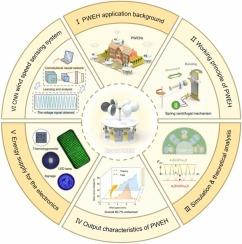当前位置:
X-MOL 学术
›
Nano Energy
›
论文详情
Our official English website, www.x-mol.net, welcomes your
feedback! (Note: you will need to create a separate account there.)
A centrifugal spring mechanism empowers self-adjusting in piezoelectric wind energy harvesting
Nano Energy ( IF 16.8 ) Pub Date : 2024-11-09 , DOI: 10.1016/j.nanoen.2024.110462 Weilin Liao, Xiaosen Su, Fei Fang
Nano Energy ( IF 16.8 ) Pub Date : 2024-11-09 , DOI: 10.1016/j.nanoen.2024.110462 Weilin Liao, Xiaosen Su, Fei Fang

|
Piezoelectric wind energy harvesters (PWEHs) offer promises in sustainable green energy supply for micropower electronics. However, traditional PWEHs encounter challenges in terms of high start-up wind speeds, subpar output performance, and narrow bandwidth, hampering their widespread adoption. To enhance the energy capture efficiency, a novel self-adjusting PWEH integrating a centrifugal spring mechanism (CSM) is presented. The CSM consists of a sliding rod, a 304 stainless steel spring, an exciting magnet, and a mass block. Additionally, the PWEH employs a vertical-axis blade design, allowing it to capture wind from different directions. Via theoretical analyses, finite element simulations, and experiments, key parameters of the PWEH are optimized including the CSM additional mass, spring wire diameter, and the configuration of multi-frequency piezoelectric transducers. Results demonstrate that the optimized PWEH works at 1.5 m/s and generates 0.45 mW, 2.742 mW, and 5.973 mW at wind speeds of 2 m/s, 3.3 m/s, and 4.75 m/s, respectively. Compared to the unoptimized PWEH, the introduction of the CSM results in an 80.7 % enhancement in open-circuit voltage and a 90.9 % increase in short-circuit current. Additionally, by utilizing four pairs of piezo-transducers with different resonance frequencies (6.83 Hz, 9.38 Hz, 12.1 Hz, and 14.8 Hz), the resonance bandwidth of the PWEH is expanded to 1.5–5.5 m/s. The feasibility of PWEH for powering signage, electronic screens, and Bluetooth thermohygrometer is demonstrated. The potential of PWEH in constructing high-precision intelligent wind speed monitoring systems is tested via convolutional neural networks. The study offers a strategy for designing the PWEH for both powering of the microelectronic devices, and intelligent sensing and monitoring of wind.
中文翻译:

离心弹簧机构可在压电风能收集中实现自我调节
压电风能收集器 (PWEH) 为微功率电子产品的可持续绿色能源供应提供了希望。然而,传统的 PWEH 遇到了高启动风速、低于标准的输出性能和窄带宽方面的挑战,阻碍了它们的广泛采用。为了提高能量捕获效率,提出了一种集成离心弹簧机构 (CSM) 的新型自调节 PWEH。CSM 由一根滑杆、一个 304 不锈钢弹簧、一个励磁体和一个质量块组成。此外,PWEH 采用垂直轴叶片设计,使其能够捕获来自不同方向的风。通过理论分析、有限元模拟和实验,优化了 PWEH 的关键参数,包括 CSM 附加质量、弹簧丝直径和多频压电换能器的配置。结果表明,优化后的 PWEH 工作在 1.5 m/s,在 2 m/s、3.3 m/s 和 4.75 m/s 的风速下分别产生 0.45 mW、2.742 mW 和 5.973 mW。与未优化的 PWEH 相比,CSM 的引入导致开路电压提高了 80.7%,短路电流增加了 90.9%。此外,通过使用四对具有不同谐振频率(6.83 Hz、9.38 Hz、12.1 Hz 和 14.8 Hz)的压电换能器,PWEH 的谐振带宽扩展到 1.5-5.5 m/s。证明了 PWEH 为标牌、电子屏幕和蓝牙温湿度计供电的可行性。通过卷积神经网络测试了 PWEH 在构建高精度智能风速监测系统方面的潜力。 该研究为设计微电子设备供电以及风的智能传感和监测提供了一种策略。
更新日期:2024-11-09
中文翻译:

离心弹簧机构可在压电风能收集中实现自我调节
压电风能收集器 (PWEH) 为微功率电子产品的可持续绿色能源供应提供了希望。然而,传统的 PWEH 遇到了高启动风速、低于标准的输出性能和窄带宽方面的挑战,阻碍了它们的广泛采用。为了提高能量捕获效率,提出了一种集成离心弹簧机构 (CSM) 的新型自调节 PWEH。CSM 由一根滑杆、一个 304 不锈钢弹簧、一个励磁体和一个质量块组成。此外,PWEH 采用垂直轴叶片设计,使其能够捕获来自不同方向的风。通过理论分析、有限元模拟和实验,优化了 PWEH 的关键参数,包括 CSM 附加质量、弹簧丝直径和多频压电换能器的配置。结果表明,优化后的 PWEH 工作在 1.5 m/s,在 2 m/s、3.3 m/s 和 4.75 m/s 的风速下分别产生 0.45 mW、2.742 mW 和 5.973 mW。与未优化的 PWEH 相比,CSM 的引入导致开路电压提高了 80.7%,短路电流增加了 90.9%。此外,通过使用四对具有不同谐振频率(6.83 Hz、9.38 Hz、12.1 Hz 和 14.8 Hz)的压电换能器,PWEH 的谐振带宽扩展到 1.5-5.5 m/s。证明了 PWEH 为标牌、电子屏幕和蓝牙温湿度计供电的可行性。通过卷积神经网络测试了 PWEH 在构建高精度智能风速监测系统方面的潜力。 该研究为设计微电子设备供电以及风的智能传感和监测提供了一种策略。


















































 京公网安备 11010802027423号
京公网安备 11010802027423号